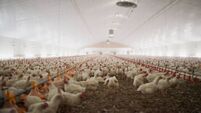Two thirds of an acre. That’s how much goes under solar panels globally every second

Most farms, industrial buildings and homes will get 25 to 30% of their energy from solar photovoltaic equipment in the future, said Paul Kenny of the Tipperary Energy Agency, at the recent Energy In Agriculture event at Gurteen College, Roscrea, Co Tipperary.
He also envisaged use of batteries to enable selling power to the electricity grid.
“Boilers will be replaced with heat pumps that will run summer water loads,” said Mr Kenny.
In his presentation on generating your own power, and farm scale electricity, Mr Kenny revealed that two thirds of an acre is going under solar panels globally every second.
He said small scale wind will work economically on very windy sites. For example, a large dairy and dwelling house with heat pumps and electric vehicles could work effectively with a wind generator in a windy location.
Poultry and pig farms with heat pumps would also have a large enough load to be suitable for wind generation.
Small loads like fences, remote lighting, small pumps could be off grid more economically, powered by standalone wind or solar, than bringing in an electricity supply.
Experts at the Energy In Agriculture event gave advice on reducing energy costs, and on schemes such as the new roof-top solar PV grant scheme for homes (for which farmers need separate yard and home electricity meters), and grants for dairy farmers to install variable speed drive vacuum pumps and milk pumps.
Farmers were told their renewable energy projects will become viable in the new Support Scheme for Renewable Heat (SSRH), and the Renewable Electricity Support Scheme (RESS).
Agriculture, commercial, public service, industrial and district heating are all SSRH-eligible sectors, and it is planned to open this scheme for applications later this year. The budget for the scheme is €18m per year for 15 years.
Ray Langton of the Sustainable Energy Authority Of Ireland said SSRH presents a range of new business and financial opportunities for the agriculture sector.
For example, a 320 kilowatt boiler on a poultry farm could pay for itself in 3.4 years.
SSRH support for the €240,000 boiler would total €39,370, and using wood chip instead of bulk LPG would save €31,025.
In Sweden, 60% of all heat demand is supplied by district heating, 50% fuelled by biomass such as straw, woodchip, wood pellets, willow and cereal, said Donna Gartland, Director, Irish District Energy Association, and Executive Energy Planner in Codema, Dublin’s Energy Agency set up by Dublin City Council in 1997.
Swedish farming co-ops of up to 25,000 members each produce biomass for district heating.
For district heating and other ways to unlock the potential of the private forest resource, co-ordination and operation between small scale farm forests is the key, said IFA Farm Forestry Executive Geraldine O’Sullivan.












